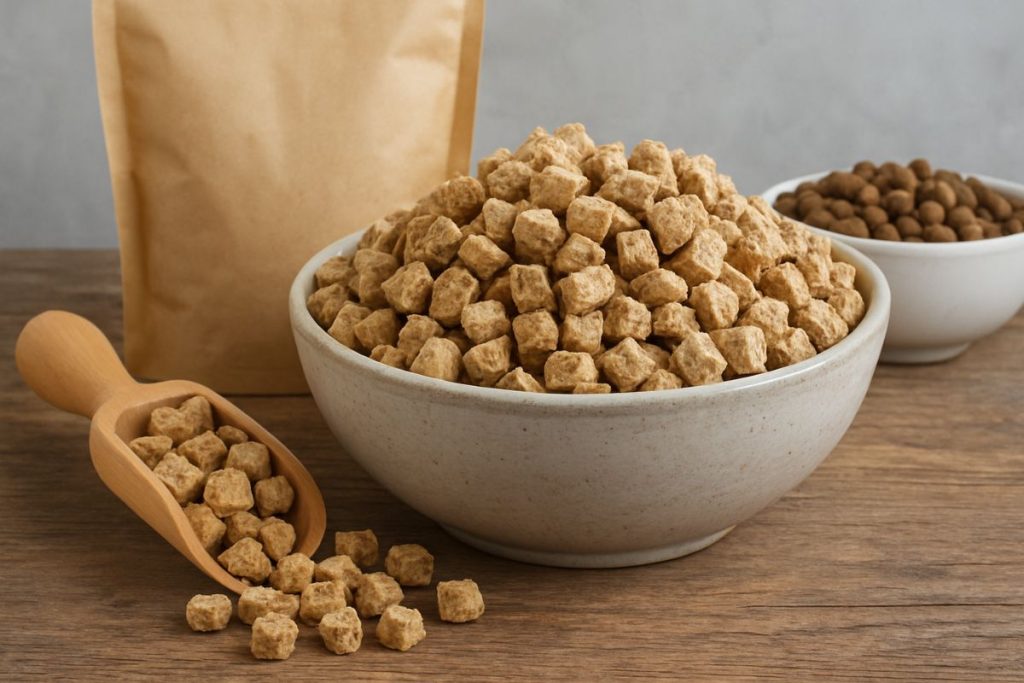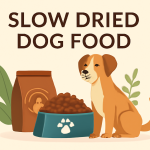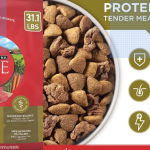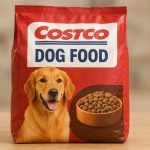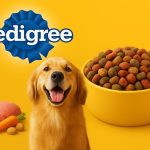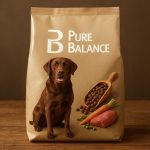Meta Title: Raw Dog Food: Freeze-Dried Dog Food | Lightweight & Nutritious
Meta Description: Discover why raw dog food, especially freeze-dried dog food, is lightweight and nutritious. Learn benefits, top brands (Dr. Marty, Instinct), and feeding tips.
Raw Dog Food: Freeze-Dried Dog Food – Lightweight & Nutritious
Freeze-dried dog food is a form of raw dog food that has exploded in popularity among pet owners seeking a natural, nutrient-packed diet. Freeze-drying preserves raw ingredients by freezing them and removing moisture through sublimationcolumbusboarding.com. The result is a dry, shelf-stable food that locks in most of the vitamins, minerals and enzymes found in fresh raw ingredients. In fact, research shows that freeze-drying minimally damages natural nutrients compared to cooking, so the final product remains extremely nutrient-densecolumbusboarding.comwhole-dog-journal.com. Many owners find freeze-dried raw diets not only healthier for dogs, but also lightweight and convenient for travel or storage (water is ~70% of fresh meat weight, removed by freeze-drying). Throughout this article we’ll explore freeze-dried dog food in depth: its nutrition, pros and cons, comparisons with other diets (kibble, wet, frozen raw), and tips for feeding. We’ll also highlight top brands like Dr. Marty’s and Instinct.
Figure: A dog sniffing at a jar of freeze-dried raw dog food (lightweight, high-protein nutrition).
What Is Freeze-Dried Raw Dog Food?
Freeze-dried dog food starts with quality raw dog food ingredients (meats, organs, fruits/vegetables, sometimes bone). These ingredients are first frozen, then placed in a vacuum chamber. Under low pressure and gentle heat, the frozen water in the food sublimates (turns directly from ice to vapor) and is removedcolumbusboarding.comwhole-dog-journal.com. Because the food never reaches high cooking temperatures, its natural structure stays intact. The result is a dry product containing the same real foods (meat, organs, veggies) your dog would eat in a fresh raw diet, but with the moisture extracted.
This process yields a raw, lightly processed diet. Unlike kibble (dry dog food), which is highly cooked, freeze-dried raw food retains the “raw” status of its ingredientspetmd.comwhole-dog-journal.com. As PetMD explains, freeze-drying “allows the ingredients to remain unchanged”, preserving taste, smell and structurepetmd.com. In practice, freeze-dried foods often come as small nuggets or patties that are easy to crumble, rehydrate, or serve as-is. They often require no refrigeration until opened, giving them a long shelf life for a raw dietpetmd.comcolumbusboarding.com.
In short, freeze-dried raw dog food is real raw food that has been gently preserved. It offers all the key elements of a raw diet – high-quality meat proteins and fresh ingredients – in a convenient, shelf-stable formcolumbusboarding.comwhole-dog-journal.com.
Nutritional Benefits of Freeze-Dried Dog Food
Freeze-dried raw diets are prized for their nutrient retention and natural composition. Key benefits include:
- Superior Nutrient Retention: Freeze-drying removes moisture without high heat, so essential vitamins, minerals and enzymes are largely preservedcolumbusboarding.comwhole-dog-journal.com. In fact, research notes there is almost no nutrient loss in freeze-dried foods compared to fresh rawleckerbites.net. This means your dog is getting a more “complete” meal: the same vitamins and amino acids that were in the fresh meat remain available. Veterinarians note that these diets are “nutrient-dense” due to this retentionpetmd.com.
- High-Quality Protein, Minimal Fillers: Freeze-dried foods are typically over 90% meat and organsstellaandchewys.comstellaandchewys.com, mirroring a dog’s ancestral diet. They rarely contain grains or starches – PetMD notes “most freeze-dried foods do not contain grains or starches” because they rely on protein for energypetmd.com. This makes them naturally grain-free dog food options (useful for dogs with grain sensitivities). They also tend to avoid common fillers (peas, potatoes, soy) as seen in premium brandsstellaandchewys.comcolumbusboarding.com. The clean ingredient list reduces allergens and unwanted additives.
- Enhanced Digestibility: Minimal processing means the proteins and enzymes are more bioavailable. Dogs often digest freeze-dried recipes easily, with fewer stomach upset issuespetmd.comcolumbusboarding.com. For example, the inclusion of pre-biotics, probiotics or raw bone in some formulas can support healthy digestion. One reviewer noted that “freeze-dried raw food retains all of the nutrients and enzymes that are present in raw meat,” aiding natural digestionleckerbites.net. Whole Dog Journal also reports these diets are highly palatable and easy on the gut – dogs with poor appetites often accept them readilywhole-dog-journal.com.
- Healthy Skin and Coat: The top-quality fats and proteins (often with omega-3 fatty acids from fish or flax) support coat and skin health. Columbus Boarding notes that freeze-dried foods, with their “whole, natural ingredients,” can lead to “healthier skin and coat, and increased energy levels”columbusboarding.com. Owners often report glossier fur and more energy on these diets.
- Weight Management: Because freeze-dried food is very concentrated, dogs need to eat smaller volumes to get the same calories. There are no cheap fillers to bulk up kibble, so each bite is pure nutrition. This can help dogs feel satisfied on less, which may prevent overfeedingcolumbusboarding.com. The high protein and lack of grains can also help maintain lean muscle and a healthy weight.
- Long Shelf Life & Convenience: Without water, freeze-dried raw packs are extremely shelf stable. They can sit in the pantry for months (often up to a year) if unopenedpetmd.comcolumbusboarding.com. They weigh far less than frozen raw (since water is heavy), making them easy to carry on trips or camping. Columbus Boarding points out that freeze-dried food is “lightweight, easy to store, and has a long shelf life without refrigeration,” making it ideal for busy ownerscolumbusboarding.com. You can serve it dry out of the bag, or quickly rehydrate it with water or broth for a fresh-feeling meal.
- Palatability: The natural flavors of raw ingredients remain locked in. Dogs often find freeze-dried meals highly tasty, even picky eaterswhole-dog-journal.comleckerbites.net. On rehydration, the aroma intensifies and many dogs act like it’s a gourmet meal. This can be great for seniors or sick dogs who have lost appetite.
Overall, freeze-dried raw dog food offers “meaty real nutrition” that taps into a dog’s instinctual dietstellaandchewys.comcolumbusboarding.com. By preserving ingredients in their near-natural state, it provides a potent, nutrient-rich meal.
How Freeze-Dried Compares: Kibble, Canned, Raw
Owners often ask how freeze-dried diets stack up against other types of dog food:
- Vs. Dry Kibble (Best Dry Dog Food): Unlike kibble, freeze-dried food is minimally processed. Kibble is cooked at high heat, which can degrade nutrients and create advanced glycation products (AGEs)petmd.comwhole-dog-journal.com. In contrast, freeze-drying avoids high temperatures, retaining natural enzymes and vitaminswhole-dog-journal.com. PetMD emphasizes that freeze-dried is a raw-meat diet made with low heat, whereas kibble is “highly processed using high heat”petmd.com. Taste is also different: dogs often prefer the fresh meat flavor of freeze-dried. However, kibble is more convenient and usually cheaper. Freeze-dried food, being premium and protein-rich, tends to cost more per pound. (A cup of freeze-dried kibble can convert to several cups of rehydrated meat.) In short, freeze-dried raw offers superior nutrition and digestibility, but at a higher price point compared to most dry dog foods.
- Vs. Canned (Wet) Dog Food: Canned foods are also high in moisture and often real meat, but they are still cooked and can contain additives. Freeze-dried can be more nutrient-intact than canned, since the heat in canning is often quite high. That said, quality wet foods with added broths and meats can also be nutritious. The main difference is texture and convenience: freeze-dried is shelf-stable and dry, while canned must be refrigerated after opening.
- Vs. Frozen Raw Diets: Both frozen raw and freeze-dried raw deliver similar ingredients (meat, bone, organ). The difference is convenience. Frozen raw (frozen raw patties or chunks) must stay frozen, whereas freeze-dried can live in the pantry. Nutritionally, freeze-dried can be just as good if the recipe is balanced. Some purists prefer frozen raw as “less processed,” but freeze-dried retains nearly all the same nutrientscolumbusboarding.comwhole-dog-journal.com. One advantage of freeze-dried is safety: many brands will provide freeze-drying after high-pressure pasteurization, which can reduce pathogens without cooking (unlike raw). However, as PetMD warns, freeze-drying does not guarantee a sterile product (see Precautions below).
In summary, freeze-dried raw is a middle ground: it offers raw-quality nutrition and convenience, bridging the gap between fresh raw and convenient processed food. It’s often viewed as “premium” by nature, akin to choosing a top-tier dry food. (Indeed, DogFoodAdvisor’s “Best Dry Dog Food” lists often include freeze-dried or air-dried brands as top picksdogfoodadvisor.comdogfoodadvisor.com.)
Considerations and Precautions
While freeze-dried raw food has many perks, owners should consider a few points:
- Food Safety: Freeze-drying significantly slows microbial growth, but it does not eliminate all pathogens. PetMD cautions that “freeze-drying does not eliminate all pathogens”petmd.com. It can reduce bacteria, but some (e.g. Salmonella, E. coli) might survive in raw meat. Even handling the dry food could expose owners to germs. Veterinarians note that raw diets (even freeze-dried) have been linked to recalls due to contaminationpetmd.com. For safety, only buy reputable brands that test their products. Always wash hands and bowls after feeding raw or freeze-dried. If your dog is very young, old, immunocompromised, or in contact with infants, consult your vet. In practice, many owners feed freeze-dried raw safely by using standard precautions (gloves, handwashing, cleaning bowls).
- Complete & Balanced Nutrition: Not all freeze-dried products are nutritionally complete on their own. Some are meals formulated to meet AAFCO standards, while others are supplements/toppers meant to be added to another diet. Always check the label. Good brands will state “complete and balanced” or list AAFCO profilespetmd.comstellaandchewys.com. For example, Stella & Chewy’s notes their meals meet or exceed AAFCO nutrient profilesstellaandchewys.com. If a product is only “raw pieces” or treats, you may need to use it alongside kibble or a balanced base. Incomplete formulations can lead to nutrient gaps (e.g. calcium, vitamins). As PetMD advises, look for an AAFCO statement on the packaging to ensure the diet is balancedpetmd.com. You can also rotate proteins and supplement as needed (some owners add bone meal, oils, or multivitamins when feeding raw diets).
- Dental Health: Many freeze-dried diets include bone meal or small crushed bones. Chewing these raw bone fragments can gently clean teeth. However, some formulas have no bone at all (to avoid risks). Consider adding a separate chew or brushing routine if you rely solely on kibble cleaning.
- Cost: Freeze-dried raw is usually much more expensive than typical kibble. This is due to the cost of raw ingredients and the freeze-drying process. Expect the price per day to be on the higher end. For budget-conscious owners, freeze-dried can be used as a topper/treat on most days, with occasional frozen raw or high-quality kibble. Even small servings can go a long way in boosting nutrition.
- Grain-Free Considerations: Many freeze-dried formulas are inherently grain-freepetmd.com. While this is often marketed as a benefit, it’s important to note the recent concerns around grain-free diets. The FDA and veterinarians have investigated a possible link between grain-free dog food (especially those high in legumes/pulses) and canine dilated cardiomyopathy (a heart condition)fda.govakc.org. According to the FDA, over 90% of reported DCM cases involved grain-free formulas, often containing peas/lentilsakc.org. However, no definitive cause is proven, and many freeze-dried foods get their protein from meat (not legumes) and may include taurine-rich ingredients (fish, beef, heart). If you feed a grain-free diet for freeze-dried meals, ensure your dog’s overall diet has taurine and nutrients to support heart health. Consulting a vet about your dog’s specific needs is wise. Many vets now advise not to use a grain-free diet unless a dog truly needs it (e.g. a diagnosed grain allergy).
In short, freeze-dried raw food is not a cure-all but a powerful tool. Under veterinary guidance, it can promote health, but it must be balanced and handled safely.
Top Freeze-Dried Dog Food Brands
Numerous companies offer freeze-dried raw diets. Here are a few well-known ones that exemplify quality (keyword mentions included):
- Dr. Marty’s Dog Food: Vet Dr. Martin Goldstein’s brand offers a “Nature’s Blend” line of freeze-dried raw recipes. According to Dog Food Advisor, “Dr. Marty’s Dog Freeze-Dried Raw product range is made up of seven recipes which each receive the Dog Food Advisor’s rating, 5 stars”dogfoodadvisor.com. These recipes feature premium meats like turkey, beef, salmon and include organ meats and superfoods (e.g. sweet potato, blueberry, kale). Dr. Marty’s promotes a holistic, high-protein diet. Dog Food Advisor notes it is highly recommended with an average Dry Matter protein ~39%dogfoodadvisor.comdogfoodadvisor.com. In practice, Dr. Marty’s meals are grain-free and claim to be complete. They often include probiotics and have added taurine for heart healthstellaandchewys.com. Use “Dr. Marty dog food” as anchor or research for details on their freeze-dried offerings.
- Instinct® (Nature’s Variety) Raw Meals: Instinct is a popular brand of raw dog food. Their Instinct Raw Freeze-Dried Meals (often called Raw Boost) come in several flavors (beef, lamb, chicken, pollock). Dog Food Advisor reports their freeze-dried meals have “five recipes with ratings varying from 4 to 5 stars”, average 5★dogfoodadvisor.com. These formulas start with cage-free meats and organ meat, and include nutrient-rich add-ins like salmon oil, pumpkin seeds and applesdogfoodadvisor.com. Instinct emphasizes minimal processing for better digestiondogfoodadvisor.com. Many Instinct recipes are also grain-free. For example, the Raw Meals Chicken recipe contains chicken, beef organ meats, cod, squash and vitaminsdogfoodadvisor.com. Instinct’s Freeze-Dried Raw range is widely available at pet retailers.
- Stella & Chewy’s: This veteran brand pioneered freeze-dried diets. Their Freeze-Dried Raw Dinner Patties and Meal Mixers use 95% meat and organsstellaandchewys.com, fortified with vitamins, minerals and taurine to meet AAFCO profilesstellaandchewys.com. Stella & Chewy’s highlights that their foods are “minimally processed” and “freeze-dried for maximum nutrient preservation”. They are known for being free of common fillers (peas, lentils, potatoes) and often include added probioticsstellaandchewys.comstellaandchewys.com. Their products can be fed dry or rehydrated, and serve as complete meals or toppersstellaandchewys.com. Many veterinarians recognize Stella & Chewy’s as a top raw dog food brand.
- Primal Pet Foods: Primal offers freeze-dried raw patties and nuggets. Ingredients are typically organic-certified meats and produce. They come in grain-free formulas such as Chicken & Sardine or Beef Liver, and have a “RawCoat” formula with added kelp for skin/coatleckerbites.net. Their philosophy is high-meat, low-carb.
- Northwest Naturals, Bravo, Sojos, Other: There are many other quality freeze-dried and dehydrated raw products. Some like Northwest Naturals and Bravo pride themselves on AAFCO-compliant formulas with human-grade ingredients. Others like Sojos use freeze-dried ingredients to rehydrate at home. All follow the same principle of raw nutrition preservation.
Choosing a Brand: Look for reputable companies with transparent sourcing and feeding instructions. Check if they have an AAFCO statement. Brands that partner with vets or have nutritionists formulating their diets are a plus. Also note if the formula is labeled as “complete & balanced” for all life stages or needs mixing with kibble. Reading reviews (e.g. DogFoodAdvisor, pet blogs) can give insight into palatability and any digestive issues.
How to Feed Freeze-Dried Dog Food
Feeding freeze-dried raw is straightforward, but a few tips help:
- Mix or Serve Dry: You can feed freeze-dried dog food straight from the bag as a dry diet or treat. Dogs often eat it dry like kibble. Alternatively, you can rehydrate it by adding warm water or broth. A common ratio is roughly 1 part food to 1–1.5 parts water (check package instructions). After a few minutes, the food will plump up like fresh raw. Many owners do this to mimic a raw meal texture. Columbus Boarding suggests you can “rehydrate by adding water,” which makes meal prep quick and easycolumbusboarding.com.
- Transition Gradually: If your dog isn’t used to raw diets, introduce freeze-dried slowly. Start by mixing a small portion (25%) with their current food, gradually increasing the freeze-dried amount over a week. Watch for any digestive upset during transition. Because freeze-dried is high in protein and fat, some dogs need time to adjust from a carb-heavy kibble diet.
- Portioning: Calculate portions based on the product’s feeding guide (usually given in grams or cups per weight of dog). Keep in mind freeze-dried is concentrated; often the feeding amounts by weight are smaller than dry kibble. For example, 1 cup of freeze-dried food might rehydrate to 3 cups of real food. If feeding dry, use the product’s recommended weight or cup measure. Adjust as needed to maintain your dog’s ideal weight.
- Storage: Once opened, store freeze-dried food in a cool, dry place in an airtight container to avoid moisture. It can stay fresh for months if kept dry. No refrigeration is needed.
- As Toppers or Treats: Freeze-dried bits are great as meal toppers. Sprinkle them over kibble or wet food to enrich nutrition and entice eating. Many owners also break them into training treats. Just note: if used as a topper, account for the extra calories (you may reduce base food slightly).
- Special Diets: Some formulas are meant to be added to other foods. For example, bone meal mixers or dehydrated diets may not be complete on their own and require added protein or broth. Always read the label. Whole Dog Journal advises that these are “meat-rich dry diets” that should be made complete by rehydration or mixing with other foodswhole-dog-journal.com.
By following the guidelines on the product and watching your dog’s response, feeding freeze-dried raw can be as simple as serving his favorite kibble.
The Raw Lifestyle: Why Dogs Benefit
Feeding a raw-based diet (whether frozen or freeze-dried) aligns with a dog’s evolutionary diet. Wild canids eat raw prey – muscle meat, organs, bones, and some plant matter. Freeze-dried raw food tries to mimic that natural balance in a convenient formcolumbusboarding.com. Because of this, owners often see more energy, leaner bodies, and better overall wellness. Crucially, many of the fears around raw diets are alleviated: reputable freeze-dried foods ensure clean ingredients and handling, so dogs get raw benefits safelywhole-dog-journal.com.
Veterinarians note that freeze-dried diets can be very effective: Columbus Boarding writes, “the use of whole, natural ingredients can lead to improved digestion, healthier skin and coat, and increased energy levels”columbusboarding.com. And because freeze-dried foods are processed only enough to remove moisture, they are classified as raw diets by canine nutrition standardswhole-dog-journal.com. As one source explains, because no enzymes or vitamins are lost to cooking, the ingredients remain “raw” in essencewhole-dog-journal.com.
For dogs with allergies or sensitivities, freeze-dried diets are also appealing. They are typically free of artificial preservatives, colors or common fillers. Stella & Chewy’s, for example, markets their freeze-dried raw formulas as “free of corn, wheat, soy, peas, lentils, potato and by-products”stellaandchewys.com. This strict ingredient control helps dogs who flare up on cheaper kibbles.
Performance & Reproduction: Athletes and working dogs may benefit from the high protein and fat content for endurance. Puppies on freeze-dried raw often grow with strong bones (provided sufficient calcium). Breeders sometimes use freeze-dried toppers to boost nutrition during pregnancy and lactation (e.g. Instinct Raw is popular for this).
Bottom line: When fed correctly, raw-based freeze-dried dog food can support robust health, similar to a fresh raw diet but with practicality. Owners should still supervise treats and ensure hydration, but many report fewer allergies, firmer stools, and better vitality.
FAQs (Frequently Asked Questions)
Q: What exactly is freeze-dried dog food?
A: Freeze-dried dog food is a type of raw dog food made by freezing fresh ingredients (meat, organs, veggies) and then sublimating the water. It preserves the nutrients and enzymes better than cookingcolumbusboarding.comwhole-dog-journal.com. The final product is a dry, shelf-stable kibble-like food that’s packed with the same nutrients as fresh raw.
Q: Is freeze-dried dog food safe and nutritious?
A: Yes, when sourced from reputable brands, freeze-dried dog food is a safe and highly nutritious diet option. It retains most of the vitamins and proteins of the raw ingredientscolumbusboarding.com. However, because it is still raw meat, there is a small risk of pathogens (like Salmonella). Good manufacturers often apply pressure pasteurization to reduce germs. Always handle it hygienically. Also ensure the formula is complete and balanced (meet AAFCO standards) or feed it with other foods to avoid nutrient gapspetmd.comstellaandchewys.com.
Q: How do I transition my dog to freeze-dried food?
A: Start slowly by mixing a little freeze-dried food with your dog’s current diet, then gradually increase the amount over 5–7 days. This helps the digestive system adjust to the higher protein/fat content. Monitor stools and appetite. Many dogs adjust easily; some love it immediately due to the rich taste. You can feed it dry or rehydrate first. Use the feeding guidelines on the bag to measure portions and make adjustments to maintain a healthy weight.
Q: Can I feed freeze-dried food as treats or only as a full diet?
A: Many owners use freeze-dried morsels as high-value treats or meal toppers. Because they are nutrient-rich, even a few bites can significantly enhance a meal or reward. Some brands sell “treat” versions or mixers. If using as a supplement/treat, don’t forget to adjust your dog’s overall food intake so he doesn’t get overweight. Always check if the product is a complete meal or needs to be part of a combined diet.
Q: My dog has a sensitive stomach; will freeze-dried food help?
A: Often yes. Many dogs with sensitive digestion do well on minimal-ingredient, high-protein diets. Freeze-dried raw has no grains or fillers that often upset dogs. Its enzymes and probiotics (in some formulas) can improve gut health. However, introduce it slowly and choose a gentle formula (e.g. a single-protein or limited-ingredient version). If your dog has a known allergy (e.g. chicken), pick a different protein. Always consult your vet if your dog has chronic GI issues or medical conditions before changing diets.
Q: Which is better: freeze-dried or raw refrigerated dog food?
A: Both aim to provide fresh nutrition. Freeze-dried is simply more convenient (no thawing, shelf-stable) and sometimes slightly more processed than a raw-frozen diet. Frozen raw must be kept in the freezer and thawed, whereas freeze-dried is ready to feed immediately. Nutritionally, a high-quality frozen raw and a high-quality freeze-dried raw can be equivalent if formulated properly. The choice depends on your lifestyle and budget.
Conclusion
Freeze-dried dog food represents a lightweight, nutrient-rich form of raw dog food that appeals to many modern pet owners. It delivers the health benefits of a raw diet – high protein, natural ingredients, and minimal processing – while being convenient to store and servecolumbusboarding.comleckerbites.net. Brands like Dr. Marty’s and Instinct have shown that freeze-dried recipes can achieve top nutrition ratingsdogfoodadvisor.comdogfoodadvisor.com. When used thoughtfully, freeze-dried food can help dogs have shinier coats, healthier digestion, and more energy. However, it’s important to choose balanced formulas, transition dogs gradually, and handle the food safely. As research and veterinary insight continue to evolve (for example, regarding grain-free dietsakc.orgfda.gov), owners should stay informed and work with their vet.
Ultimately, the best freeze-dried dog food is one that fits your dog’s individual needs. By comparing ingredients, looking for AAFCO compliance, and integrating keywords like dr marty dog food, instinct dog food, grain free dog food, and best dry dog food thoughtfully in your search, you can find high-quality options. Many pet parents find that freeze-dried raw becomes a cornerstone of a healthy feeding plan, boosting overall nutrition.
For tailored advice, always discuss your dog’s diet with a veterinarian or canine nutritionist. Your pet’s health and wellbeing can thrive on freeze-dried raw – it’s a premium way to bring your dog’s diet closer to nature, while keeping mealtime practical and mess-free.
Enjoyed this guide? Have experience with raw diets or freeze-dried food? Share your thoughts and questions below, and consider sharing this article with fellow dog lovers!
Sources: Authoritative pet health sites and industry sources were used for this article, including PetMDpetmd.competmd.com, Whole Dog Journalwhole-dog-journal.comwhole-dog-journal.com, Columbus Boardingcolumbusboarding.comcolumbusboarding.com, FDA/AKC alerts on grain-free dietsfda.govakc.org, and DogFoodAdvisor reviewsdogfoodadvisor.comdogfoodadvisor.com, among others, to ensure accuracy.

